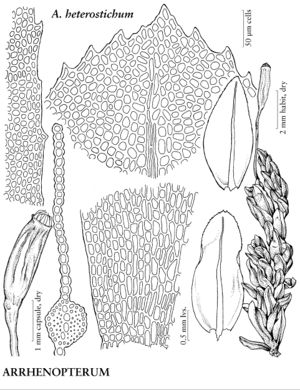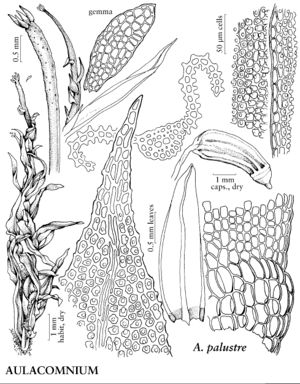Plants small to large; subgametangial branching common. Stems yellow-green, brown, or reddish brown; cross section irregularly pentagonal, hyalodermis interrupted or absent, cortical cells in 2–6 layers, small, walls thick, medulla thick, cells large, walls usually thick, central strand prominent; rhizoids smooth or roughened; axillary hairs usually 5 cells, basal cells 1 or 2, short, walls brown, apical cell elongate, hyaline. Leaves radially arranged or somewhat complanate, lanceolate, linear-lanceolate, oblong-lanceolate, oblong-elliptic, or oblong-ovate; costa abaxial surface shiny, stereid bands 2, guide cells in 1 row or sometimes 2 at base, abaxial and adaxial costal epidermis well developed or not; laminal cell walls collenchymatous or not. Specialized asexual reproduction common, by propagula terminal on leafless stem apices. Sexual condition dioicous or autoicous; perigonia as terminal discoid splash platforms, or budlike and in series down stems of male plants, sometimes below terminal perichaetia, outer and inner leaves dimorphic; perichaetia terminal; paraphyses present or absent, isomorphic or weakly differentiated between female and male plants. Seta usually single, erect or slightly inclined, twisted, smooth. Capsule inclined or horizontal, furrowed; exothecial cells differentially thickened in longitudinal bands; stomata restricted to inconspicuous hypophysis, phaneropore; annulus 2-seriate, revoluble; operculum rostrate, rostrum short or long, usually blunt; peristome diplolepidous, alternate; exostome papillose; endostome well developed, cilia 2–4, often nodose or nodulose. Calyptra cucullate. Spores 8–20 µm, smooth or papillose.
Distribution
North America, Mexico, West Indies, South America, Europe, Asia, Africa, Pacific Islands, Australia.
Discussion
Genera 2, species 5 (2 genera, 5 species in the flora).
Aulacomniaceae are found in the Northern Hemisphere including the high Arctic region, and sporadically in the Southern Hemisphere. Leptotheca Schwägrichen was long included in Aulacomniaceae (V. F. Brotherus 1924), but peristome and gametophytic structure (S. P. Churchill and W. R. Buck 1982), as well as molecular evidence (N. E. Bell et al. 2007), indicate affinities elsewhere (with Rhizogoniaceae, Churchill and Buck; or Orthodontiaceae, B. Goffinet et al. 2008). The molecular results of Bell et al. joined Aulacomnium, Hymenodontopsis Herzog, and Mesochaete Lindberg in a newly recognized Aulacomniales. Goffinet et al. placed these three genera in Aulacomniaceae (Rhizogoniales). In molecular phylogenies (Bell and A. E. Newton 2004; T. J. O’Brien 2006), Mesochaete, a genus of two species in eastern Australia (I. G. Stone 1983), one of which is also on Lord Howe Island, is sister to Aulacomnium in the broad sense (Bell and Newton; O’Brien).
Aulacomniaceae as treated here consists of two genera: Arrhenopterum (a monospecific genus usually included in Aulacomnium) and Aulacomnium, in the strict sense. T. J. O’Brien (2006) presented molecular evidence that Arrhenopterum (as Aulacomnium heterostichum) and other species in Aulacomnium that he studied are sister groups. Additional molecular and morphological studies are likely to alter the family circumscription.
Selected References
None.
Lower Taxa
Illustrations
Key
| 1 | Leaves lanceolate, oblong-lanceolate, linear-lanceolate, or oblong-elliptic, spirally arranged, symmetric; bases tapered, scarcely tapered, or slightly rounded to insertion, broad; margins often irregularly serrulate at apex; laminal cell papillae prominent, abaxial and adaxial cell surfaces plane to somewhat domed; sexual condition dioicous. | Aulacomnium |
| 1 | Leaves oblong-ovate, ± complanate, often asymmetric; bases abruptly rounded to insertion, narrow; margins strongly serrate distally; laminal cell papillae weakly developed or absent, abaxial and adaxial cell surfaces bulging; sexual condition autoicous. | Arrhenopterum |


